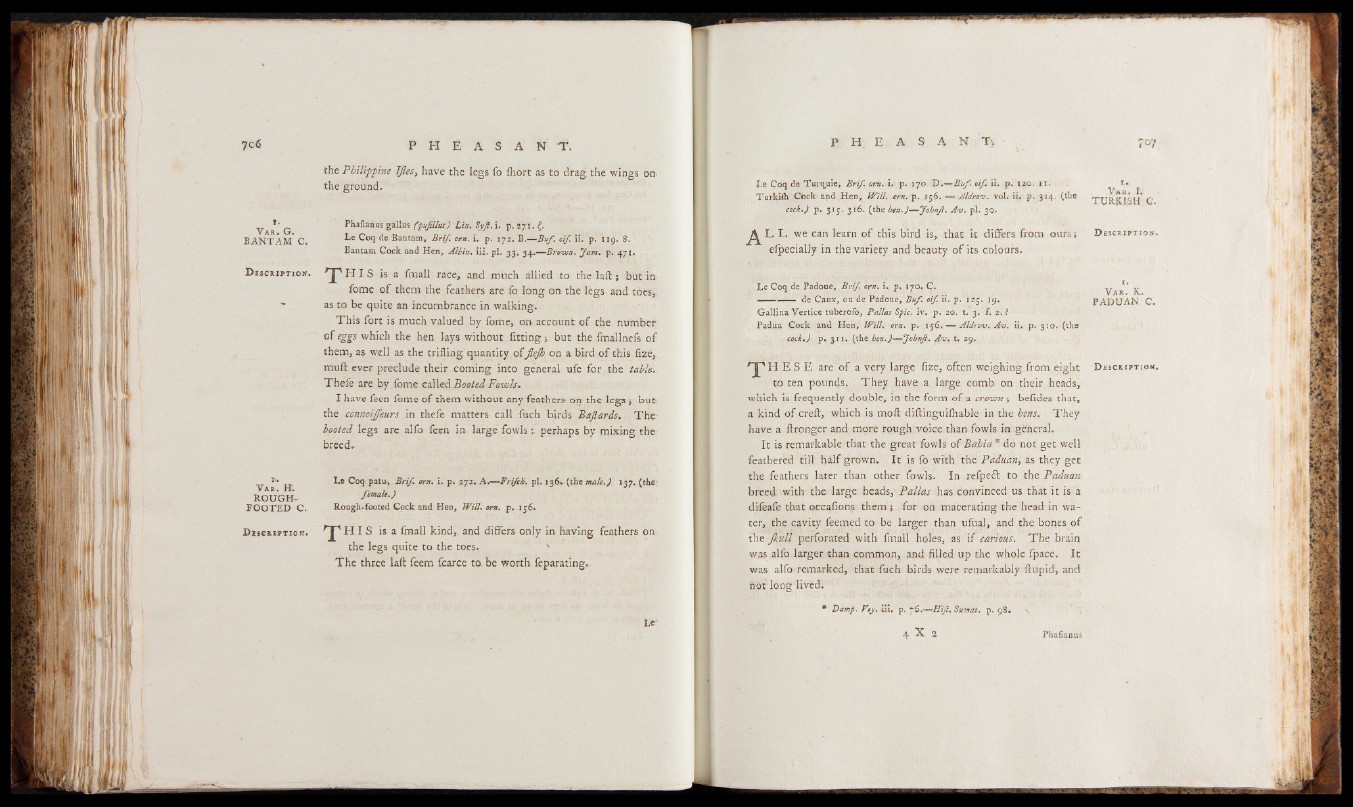
?c6 P H E A S A N T .
the Philippine Ifles, have the legs fo fhort as to drag the wings on
the ground. '
Var. G.
BANTAM I g
Phafianus gallus fpußllus) Lin. Syß. i. p. 271. £.
Le Coq de Bantam, Brif. orn. i. p. 172. B.—Buf. oif. ii. p. 119. 8.
Bantam Cock and Hen, Albin. iii. pi. 3.3. 34.-—Brown. Jam» p. 471,
Description. 1 H I S is a fmall race, and much allied to the laft j but in
fome of them the feathers are fo long on the legs and toes,,
as to be quite an incumbrance in walking.
This fort is much valued by fome, on account of the number
of CSS? which the hen lays without f i ttingbut the fmallnefs of
them, as well as the trifling quantity offleß> on a bird of this fize,.
muft ever preclude their coming into general ufe for the table..
Thefe are by fome called Booted Fowls.
I have feen Ibme of them without any feathers on the legs; but
the connoijjeurs in thefe matters call fuch birds Baftards. The-
booted legs are alfo feen in large fowlsperhaps by mixing the
breed-
Var‘ HI
ROUGHFOOTED
C..
Le Coqspatip, Brif orn. i. p. 272. A,—Frifcb. pi. 136V (the male.) 137. (the.-
female.)
Rough-footed Cock and Hen, Will, orn» p - 156*
Description. T p H I S is a fmall kind, and differs only in having feathers on.
the legs quite to the toes. *
The three laft feem fcarce to be worth feparating.
Le
Le Coq de Turquie, Brif. orn. i. p. 17b D.—Buf. oif. ii. p. 120. 11.
Turkish Cock and Hen, Will. orn. p. 156. — Aldrov. vol> ii. p. 314. (the
cock.) p. 315. 316. (the beft.)— JohnJl. Av. pi. 30.
V-ar*. I.
TURKISH G.
L L we can learn of this bird is, that ic differs from ours;
efpecially in the variety and beauty of its colours.
D escription.
Le Coq de Padoue, Brif. orn. i. p. 170. C.
— de Caux, ou de Padoue, Buf. oif. ii. p. 123. 19.
Gallina Vertice tuberofo, Pallas Spic. iv. p. 20. t. 3. f. 2.?
Padua Cock and Hen,’ Will. orn. p. 156. — Aldrov. A<v. ii. p. 310. (the
cock,) p. 311. [fashen.)—~JohnJl. Av. t. 29.
i.
V a r . K.
PADUAN C.
n p H E S E are of a very large fize, often weighing from eight
to ten pounds. They have a large comb on their heads,
which is frequently double, in the form of a crown ; befides that,
a kind of creft, which is moft diftinguifhable in the hens. They
have a ftronger and more rough voice than fowls in general.
It is remarkable that the great fowls of Bahia * do not get well
feathered till half grown. It is fo with the Paduan, as they get
the feathers later than other fowls. In refpeft to the Paduan
breed with the large heads, Pallas has convinced us that it is a
difeafe that occafions them; for on macerating the head in water,
the cavity feemed to be larger than ufual, and the bones of
the Jhull perforated with fmall holes, as if carious. The brain
was alfo larger than common, and filled up the whole fpace. It
was alfo remarked, that fuch birds were remarkably ftupid, and
not long lived.
D escription.
Damp. Viy. iii. p. 76.— Hiß, Sumat. p. 98.